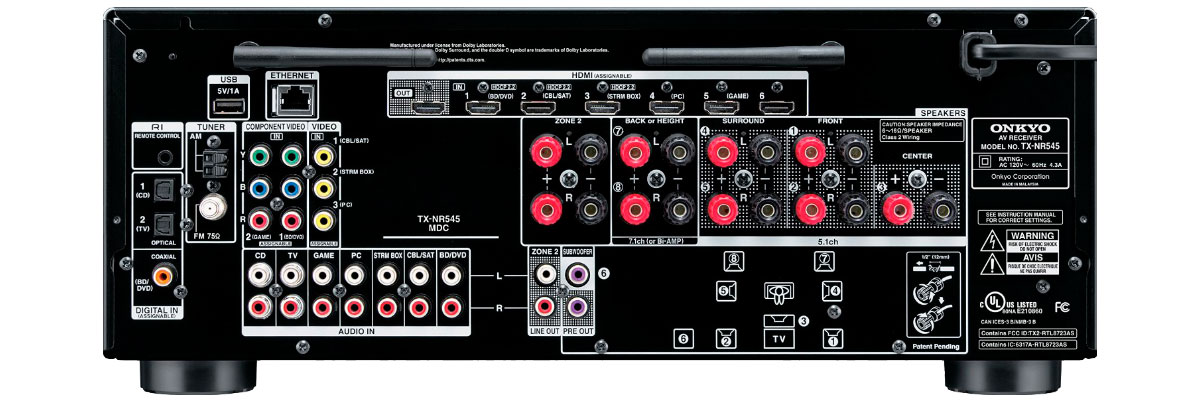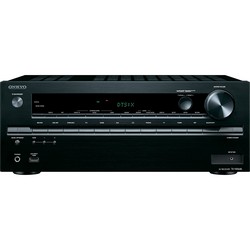 Onkyo TX-NR545 is one of the first budget AV receivers that supports Dolby Atmos formats of the near future for watching Ultra HD movies. What other Onkyo TX-NR545 specs are there check in this Onkyo TX-NR545 review.
Onkyo TX-NR545 is one of the first budget AV receivers that supports Dolby Atmos formats of the near future for watching Ultra HD movies. What other Onkyo TX-NR545 specs are there check in this Onkyo TX-NR545 review.
Onkyo TX-NR545 review
Features
The unit with 115W (6 Ohm) power supports the Dolby Atmos for watching Ultra HD movies, 4K games at 60 frames per second, with compatible HDMI inputs and HDCP 2.2 system for copy protection, which is used by various movie studios, streaming service providers, broadcast and satellite TV channels. Qdeo upscaling technology converts DVDs and low-resolution games to Full HD or 4K (if you have an Ultra HD display).
Design and build
The receiver is endowed with a pre-amplifier for the EPU electromagnetic pickup and has access to the second sounding zone. You can use the rear channels to connect additional upper front speakers, the app supports 7.2-channel Dolby Pro Logic II sound. The Onkyo TX-NR545 AV receiver is manufactured using the high-quality digital-to-analog converter AK4458 (manufacturer - Asahi Kasei), which significantly reduces noise and provides the most natural sound, since this DAC guarantees the thoroughness of a digital filter.

Connectivity
All six HDMI inputs are specification 2.0 with 4K support, and the first three are also HDCP 2.2, which will allow them to receive content from Ultra HD discs that will appear later this year. The HDMI output is also compatible with HDCP 2.2. There are also two optical and one coaxial inputs, a USB port, seven RCA analog stereo inputs, four composite and two component video inputs. This receiver can receive various audio files wirelessly via Bluetooth and Wi-Fi technology. In addition, this device supports the AirPlay interface. For user convenience, the receiver is equipped with the built-in Spotify Connect software application, which streams music.
Setup
Configuring Onkyo is no more difficult than most similar receivers; All connectors are clearly labeled. Connect the device to the network, connect the microphone for tuning - and everything will work out by itself. AccuEQ's proprietary auto-calibration software has long learned to produce accurate results. A series of test tones is short-lived - just enough time to boil the kettle.
Pros and Cons
Pros
- Flexible and versatile live setup
- Great sound dynamics immediately filled my room
- Not bulky in size. It took only a part of the shelf I placed it on
Cons
- Lack of density and detail
Common features
Product
Model
Brand
Reviews
Amplifier
Channels
Stereo power (RMS), W/Ohm
Output impedance, Ohm
Frequency response
THD in stereo, %
Audio features
Digital to analog converter (DAC)
Bi-amping
Pure direct (straight)
Auto speaker calibration
Speaker A/B switching
Other audio features
Connectivity
Wi-Fi
USB
Bluetooth
Ethernet (RJ45)
DLNA
MHL
Streaming services
Apple Music (AirPlay)
Amazon Music
Spotify
Other streaming services
Extensive connection
HDMI input/output
HDMI ARC (Audio Return Channel)
HDMI eARC (Enhanced Audio Return Channel)
HDMI CEC
Digital content protection (HDCP)
Subwoofer output (LFE)
Headphone output
Optical digital input
Coaxial digital input
Composite input
Component input/output
Phono (MM) input
Front panel connectors
Multi channel preamp output
Video features
HDR (High Dynamic Range)
4K signal pass-through
8K signal pass-through
HDMI signal pass-through
3D signal pass-through
HDMI pass-through in standby mode
Video conversion
Analog to HDMI scaling
HDMI to HDMI scaling
Dolby Vision
Other video features
Additional features
Voice control
App control
Display
Tuner
Sleep timer
Auto power off
ECO mode
Graphical user interface (GUI)
Setup assistant
Firmware update
Other additional features
Multi-room
Multi-room zones
Zone audio output
Zone HDMI output
Multi-room control
RS-232
Remote control input/output (IR)
DC trigger output (12V)
Multichannel surround
Dolby Atmos
Dolby TrueHD
Dolby Surround
Dolby (other)
DTS:X
DTS HD Master
DTS Virtual:X
DTS Neural:X
DTS (other)
Auro-3D
IMAX Enhanced
Multichannel stereo
Audio file formats
MP3
WMA
AAC
WAV
FLAC
ALAC
Other audio file formats
Power
Operational power consumption, W
Standby consumption, W
Removable power cord
User manual
Manual
Dimensions
Size W x H x D, cm/inches
Weight, kg/lbs
Other
Release year




